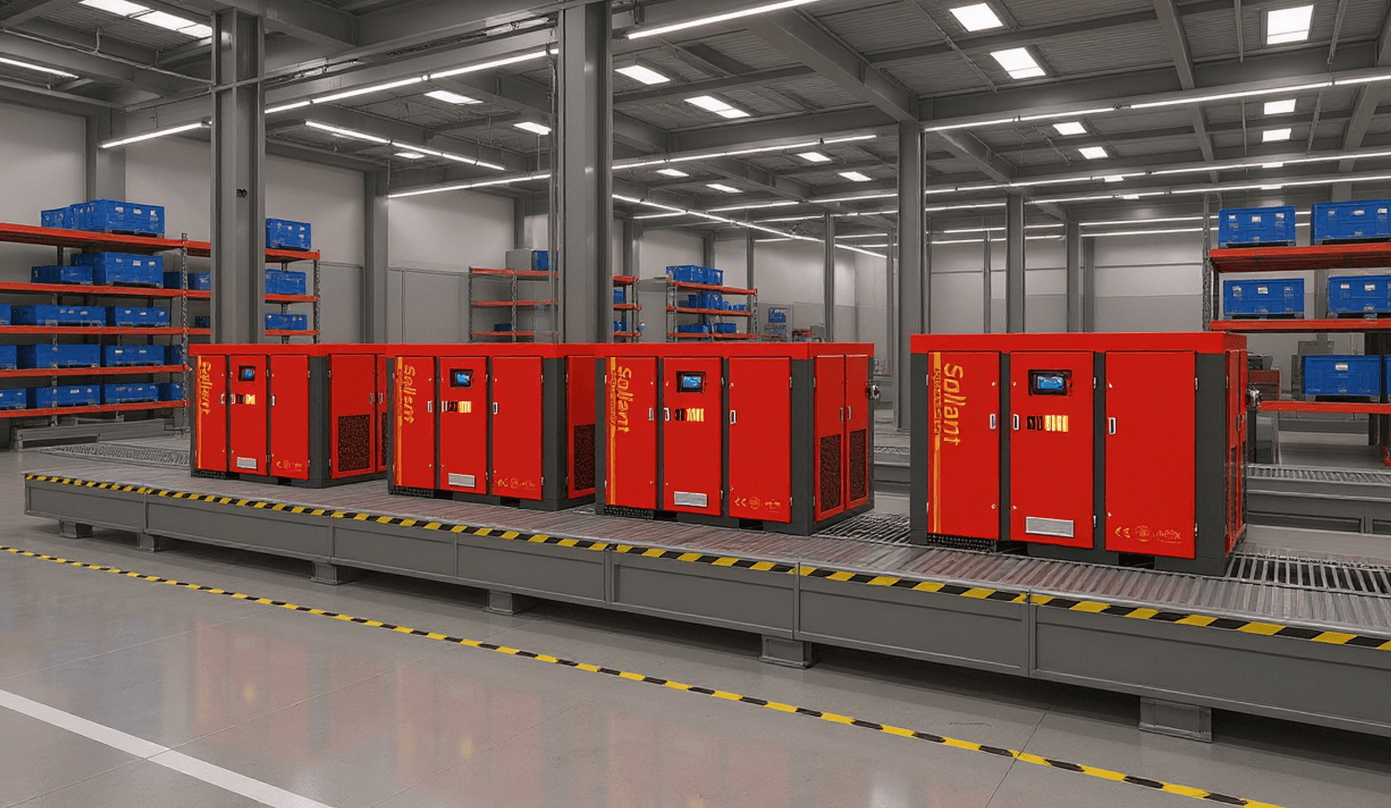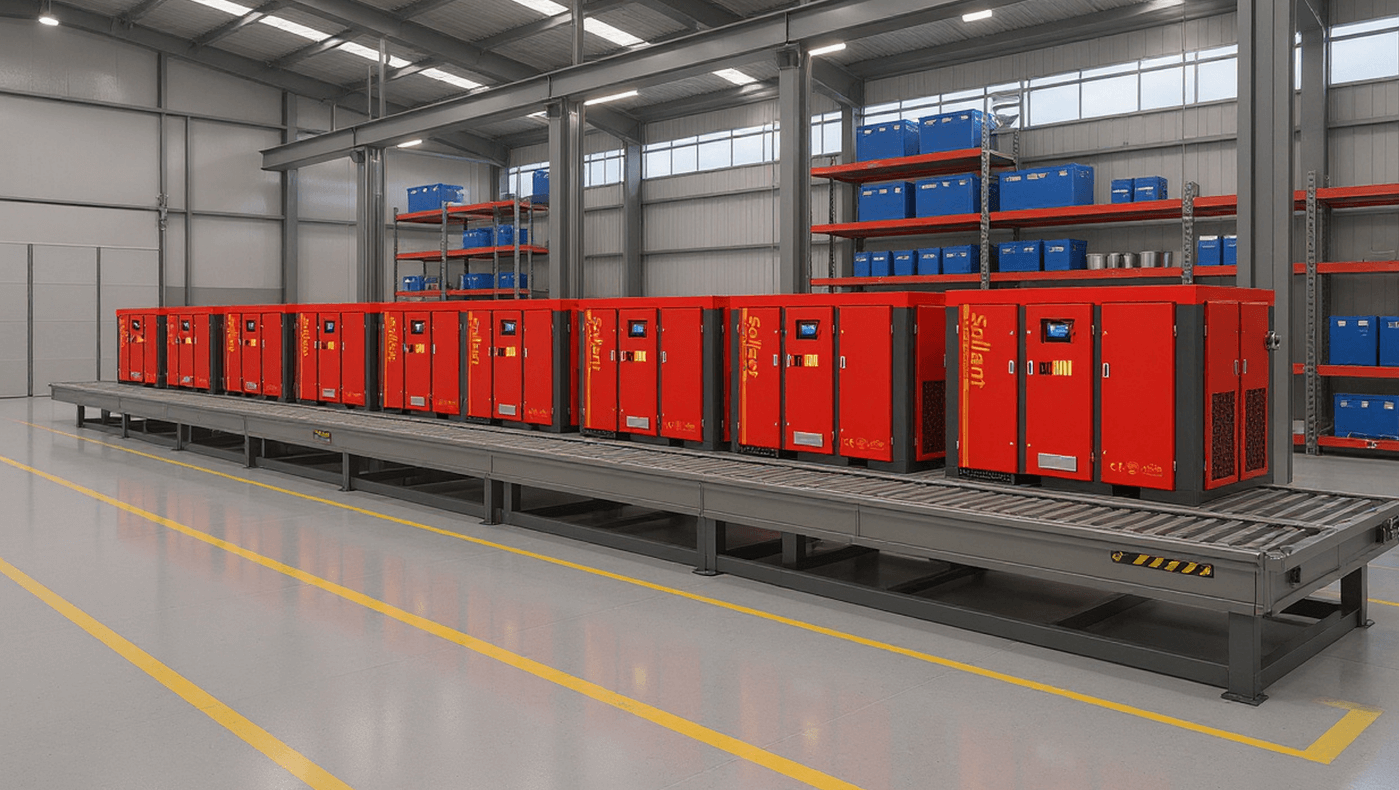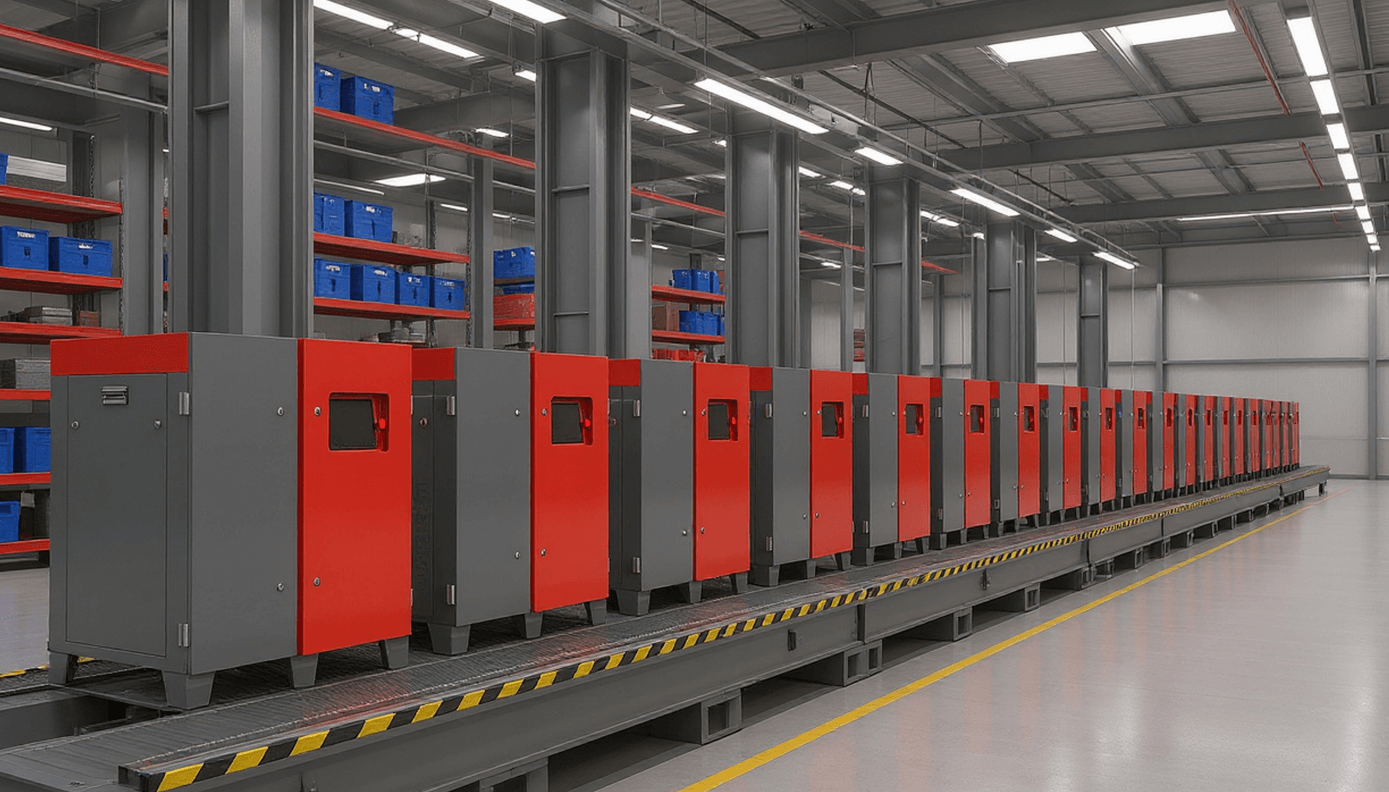Excessive Oil Consumption in Rotary Screw Air Compressors: A Practical Guide from Root Cause to Solution

Excessive oil use in Rotary Screw Air Compressors can make your costs go up fast. You might see bad air quality and have your compressor break down often. If you find problems early, you can fix them before they get worse. Sollant gives you reliable ways to help your equipment work well.
Table of Contents
Key Takeaways
Check the oil level in your rotary screw air compressor often. Make sure it stays between the ‘MAX’ and ‘MIN’ marks. This helps you find problems early.
Do a simple white paper test to look for oil in the compressed air. If you see oil stains, the separator may have a problem. Fix it right away.
Take care of your compressor by looking at seals and connectors often. Change old parts to stop oil leaks. This helps your compressor work well.
Stick to a good maintenance plan. Use the correct oil and real parts. This lowers extra oil use and helps your compressor work better.
If you see too much oil being used, act fast. Turn off the compressor, check the oil level, and clean any blockages. This stops the problem from getting worse.
Identifying Excessive Oil Consumption
Oil Level Drop Signals
You can spot excessive oil consumption early by watching the oil level in your compressor. Check the oil gauge every day. The oil should stay between the “MAX” and “MIN” marks. If you see the oil drop from “MAX” to below “MIN” in less than ten days, you have a problem. You might need to refill the oil more often than usual. This is a clear sign that your rotary screw air compressors need attention.
Tip: Always record oil levels in a logbook. This helps you track changes and spot issues faster.
Oil Content in Compressed Air
You can also check for oil in the compressed air. Take a clean white paper and hold it near the exhaust port for ten seconds. If you see oil stains on the paper, your compressor is sending oil into the air. This means the separator may not work well. Oil in the air can damage tools and lower air quality. You should start troubleshooting right away if you notice this.
Test Step | What to Look For |
|---|---|
White paper test | Oil stains = problem |
No stains | System works normally |
Abnormal Operation Signs
Your compressor may show other signs of trouble. Watch for high exhaust temperatures or sudden drops in oil pressure. You might see oil leaks around the machine. Listen for strange noises or see oil spraying during operation. These problems often mean your rotary screw compressors need repair. Early action can prevent bigger issues and keep your compressors running smoothly.
Root Causes in Rotary Screw Air Compressors
Knowing why excessive oil consumption happens helps you keep your compressor healthy. You can find problems early and fix them fast. Here are the main reasons rotary screw air compressors use too much oil.
Separator Issues
The separator keeps oil inside the compressor. It stops oil from getting into the compressed air. When the separator gets old, it does not work as well. More oil can escape with the air. Most separators work best for 2,000 to 8,000 hours. If you use it too long or pick a bad one, oil can leak and pool. Sometimes, the separator core breaks or the gasket wears out. Oil can slip through gaps and mix with air. Always check the separator and change it when needed. Sollant says to use good separator elements for smooth running.
Note: A blocked or broken separator can make oil use go up fast. It can also hurt your compressor’s performance.
Seal and Connector Failures
Seals and connectors keep oil in the right place. If they break, oil leaks happen a lot. You may see oil dripping or stains near joints. Shaft seals wear out over time. O-rings can crack or lose shape. Loose connectors or bad gaskets let oil out. The table below shows common problems and how to fix them:
Type of Failure | Causes | Solutions |
|---|---|---|
Compressor Shaft Seal Leakage | Not enough oil, broken O-rings, bad contact | Check oil, change O-rings, fix rings |
Bad gaskets, loose connectors, too much oil | Look for drips, watch oil use, tighten joints |
Check seals and connectors often when you do maintenance. Fixing them quickly stops bigger problems and keeps your rotary screw compressors working well.
Operating Condition Problems
How you use your compressor changes oil use. High exhaust temperatures make oil thin. Thin oil escapes more easily. If exhaust pressure is too high, the separator works harder. It may let more oil through. A blocked oil return line stops oil from going back to the tank. Oil builds up in the separator and leaves with the air. Running the compressor at low load for a long time makes oil and air mix badly. This lowers the separator’s power. Loading and unloading a lot also stresses the system. It can make more oil escape. Keep the compressor in the right settings. Check for blockages in the oil return pipe.
Maintenance Errors
Mistakes during maintenance can cause too much oil use. Filling the oil tank too much pushes oil where it should not go. Using the wrong oil or mixing oils changes how oil works. This makes the separator’s job harder. If you forget to change the separator or seals, oil can leak and the compressor works worse. Sometimes, people miss a blocked intake filter or oil return line. These problems can pull oil into the compression chamber and send it out with the air. Follow a strict maintenance plan. Use only the right parts and oils. Sollant’s team can help you make a plan to keep your compressors working well.
Tip: Good maintenance stops most oil leaks and helps your compressor last longer.

Scenario-Based Solutions for Rotary Screw Compressors
Emergency Actions
When you notice excessive oil consumption, you need to act fast. Quick steps can help you control the problem before it gets worse. Start by shutting down the compressor. Check the oil level right away. If the oil is above the “MAX” mark, drain some oil until it reaches the correct level. Look at the oil return line. If you see dirt or blockage, clean it with kerosene. Make sure the line is clear so oil can flow back to the tank.
Next, check the intake filter. If it looks dirty or black, replace it with a new one. Use a pressure gauge to check the exhaust pressure. Adjust it to match the recommended value on the compressor’s nameplate. Run the compressor for one or two hours. Watch the oil level and see if it drops quickly. If the oil level stays steady, you have controlled the problem for now.
Tip: Always keep a spare intake filter and oil separator on hand. This helps you fix problems quickly and avoid long downtime.
Deep Repairs
Sometimes, emergency actions are not enough. You may need to do deeper repairs to solve the root cause. Start by replacing the separator. Use a new separator element and gasket. Tighten the bolts in a crisscross pattern to make sure the seal is even. Check the pressure difference across the separator. It should be less than 0.1 MPa. If the pressure is too high, replace the separator again.
Inspect all seals and connectors. Look for oil stains or drips around the shaft and joints. Replace any worn or cracked seals. Tighten loose connectors. Use oil-resistant gaskets for better sealing. Check the oil pipes for cracks or leaks. Replace damaged pipes right away.
Adjust the operating conditions. Use a pressure regulator to keep the exhaust pressure at the right level. If your compressor runs at low load for a long time, change the operating schedule. Try to avoid running the compressor at less than 30% load for many hours. This helps the separator work better and keeps oil from escaping.
Note: Deep repairs help you fix the real cause of oil loss. They also improve your compressor’s performance metrics and reduce future problems.
Sollant Advanced Parts
Sollant offers advanced parts that help you control oil use and improve compressor reliability. These parts use high-density filter materials with nano-plating. The filters have small, even holes. This design lets air pass through easily but keeps oil inside the compressor. You get cleaner air and less oil carryover.
Sollant’s advanced parts use less oil than standard oil-flooded compressors. This means you spend less money on oil and maintenance.
High-density filter materials keep oil carryover as low as 3 ppm. This is much better than the 10 ppm or more you see in many piston compressors.
The filters resist acids, alkalis, and high temperatures. They do not change shape or break down easily.
You can customize Sollant parts to fit your rotary screw compressors. This helps you meet special needs in your factory or workshop.
Sollant’s support team can help you choose the right parts and install them. You get training and advice to keep your compressors running well. With Sollant’s advanced parts, you can lower excessive oil consumption and keep your equipment in top shape.
Sollant Advanced Parts | Standard Components |
|---|---|
Lower oil use | Higher oil use |
3 ppm oil carryover | 10+ ppm oil carryover |
Customizable | Fixed design |
High durability | Standard durability |
Callout: Using Sollant’s advanced parts helps you save money, protect your equipment, and keep your air clean.
Preventive Measures for Excessive Oil Consumption
Consumable Selection
You should pick the right parts and oil for your compressor. Always use real parts that fit your rotary screw compressors. Look for products that follow ISO rules. This helps your compressor work well and keeps your equipment safe. When you choose the correct separator and oil, you lower the chance of leaks and oil carryover. Using good lubricants keeps your compressor clean and helps it last longer.
Inspection Routine
Make a regular inspection plan to find problems early. Check the oil level every day and keep it between the marks. Look for oil leaks near the compressor. Test the oil in the air with a simple paper test. Change the filter element when needed. Clean the intake filter if it looks dirty. These steps help you find issues before they become big repairs.
Tip: Use a checklist for your inspections. This helps you remember each step and lets you track changes over time.

Maintenance Optimization
Doing regular maintenance keeps your compressor working well. Drain extra oil if the level is too high. Change bad lubricating oil right away. Make sure the separator is not broken. Remove any blockages in the oil return system. Check the opening pressure of the minimum pressure valve and change it if needed. These actions help you use less oil and make your compressor work better.
Maintenance Task | Why It Matters |
|---|---|
Drain excess oil | Stops oil carryover |
Replace filter elements | Keeps air and oil clean |
Clear oil return blockages | Stops oil from escaping |
Check separator condition | Makes sure oil separates right |
Sollant Support Services
Sollant gives strong support to help your compressors work well. You get help picking the right parts and making your inspection plan. Sollant teaches you how to do regular maintenance. Their team helps you check oil in condensed water and find leaks. They show you how to keep the oil level right and change filters on time. With Sollant’s help, you can stop excessive oil consumption and keep your rotary screw air compressors working well.
You can keep your compressor working longer if you control oil use. This also helps you save money. Doing regular checks is important. Good habits make your compressor last longer and work better.
Your compressor works better and stays clean.
Clean air is easier with regular oil checks.
Maintenance Type | Impact on Lifespan |
|---|---|
Proactive | Stops small issues from growing |
Look for broken parts and change them.
Make sure bolts and gaskets are tight.
Pick the right oil for your compressor.
Check the air filters often.
Keep an eye on the temperature.
Sollant says you should take care of the drain system. Fix oil mist problems quickly. Stop overload shutdowns before they happen. Sollant can help you keep your compressor safe and working well.

FAQ
What causes oil to leak from my rotary screw air compressor?
Oil leaks often happen when seals or connectors wear out. You should check for loose bolts, cracked pipes, or old gaskets. Replace damaged parts quickly to stop leaks and keep your equipment safe.
How often should I change the oil separator?
You should change the oil separator every 2,000 to 3,000 hours of operation. Using genuine parts helps your compressor work better and keeps oil consumption low.
Why does my compressed air have oil in it?
Oil in the air means the separator is not working well. You may need to clean or replace the separator. Check for blockages in the oil return line and make sure you use the right oil.
What is the best way to prevent excessive oil consumption?
You should follow a regular inspection routine. Use the correct oil and genuine parts. Clean filters and check for leaks often. Good habits help your compressor last longer and work better.
Can I mix different types of lubricating oil?
Mixing oils can cause problems. Always use the oil recommended by the manufacturer. Mixing different oils may lead to poor separation and higher oil carryover.


